
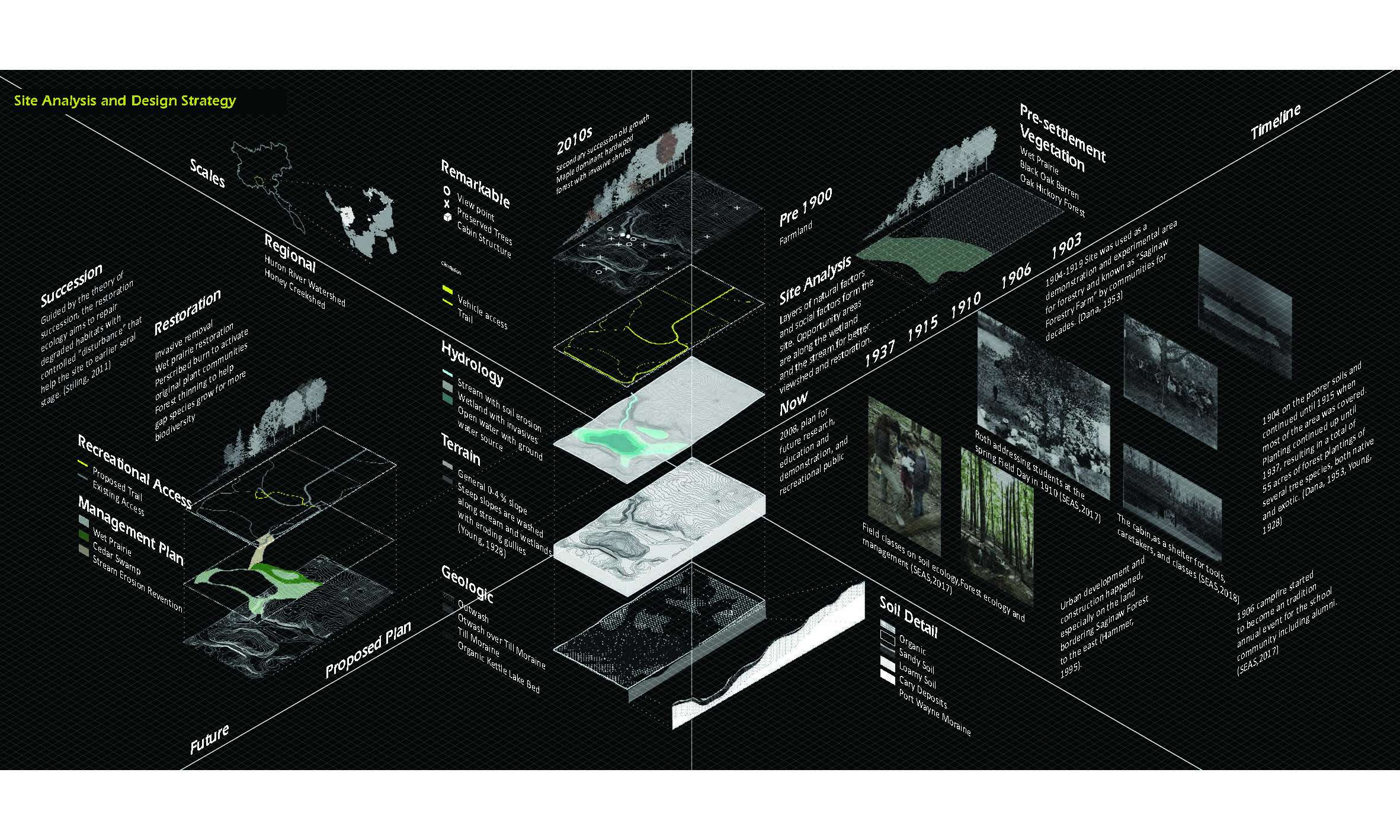
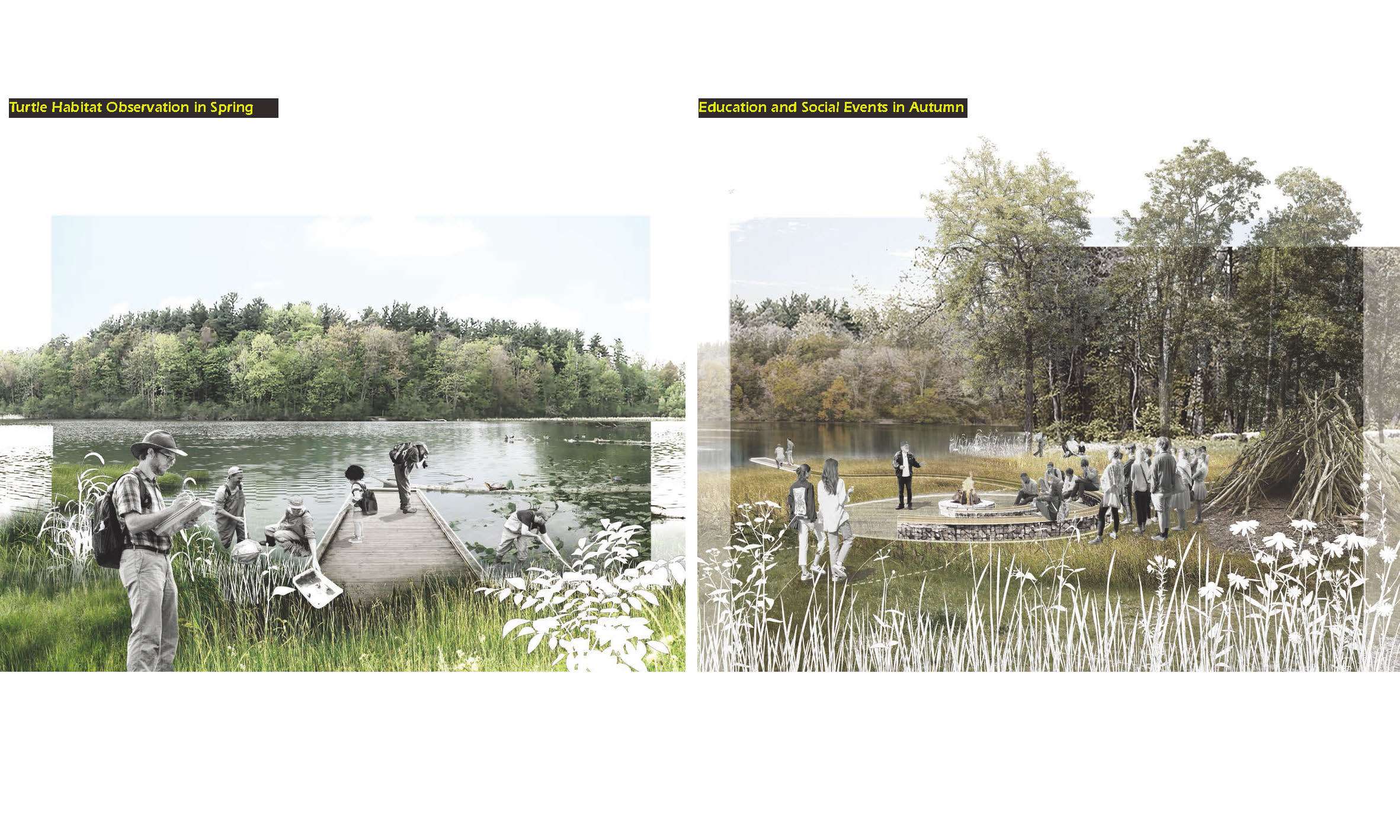

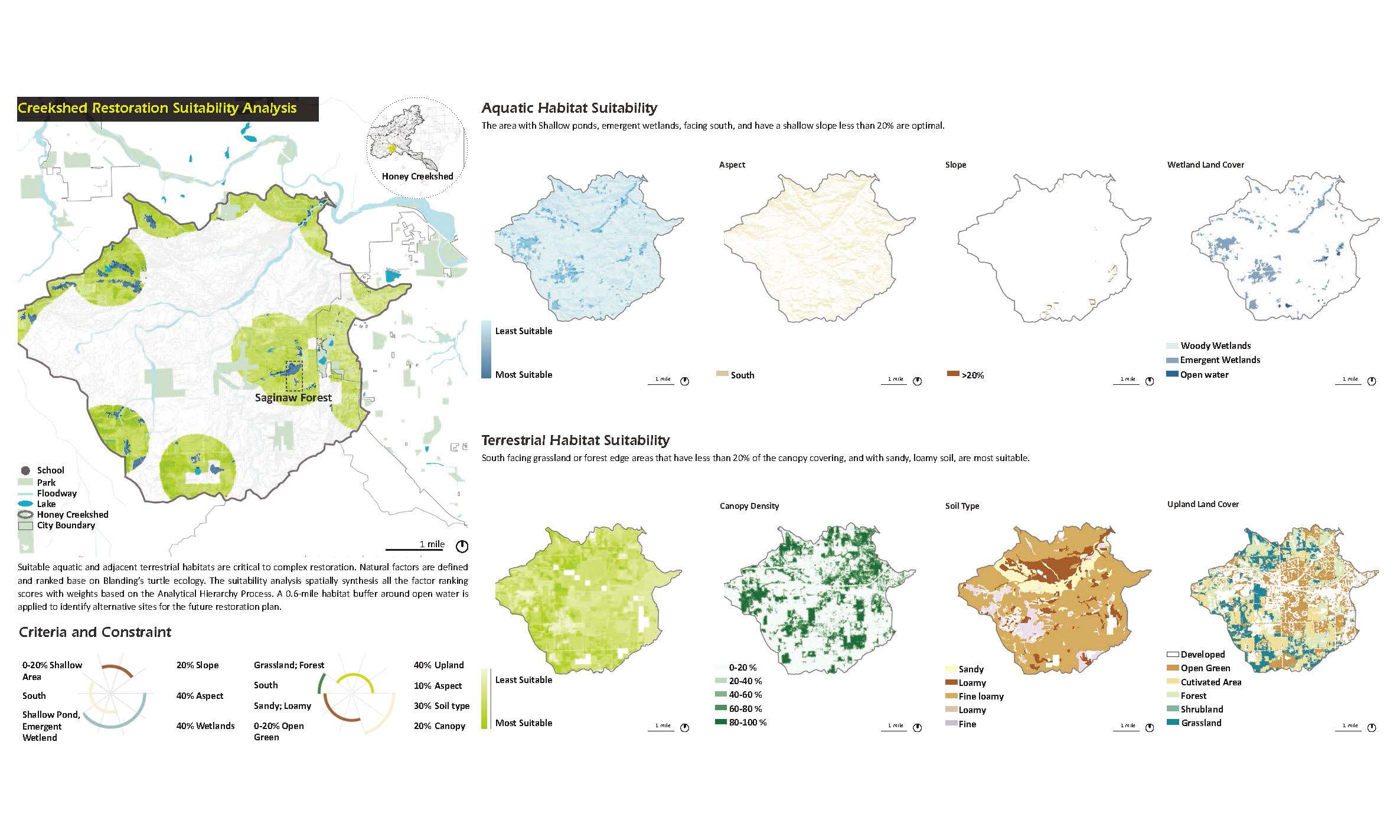
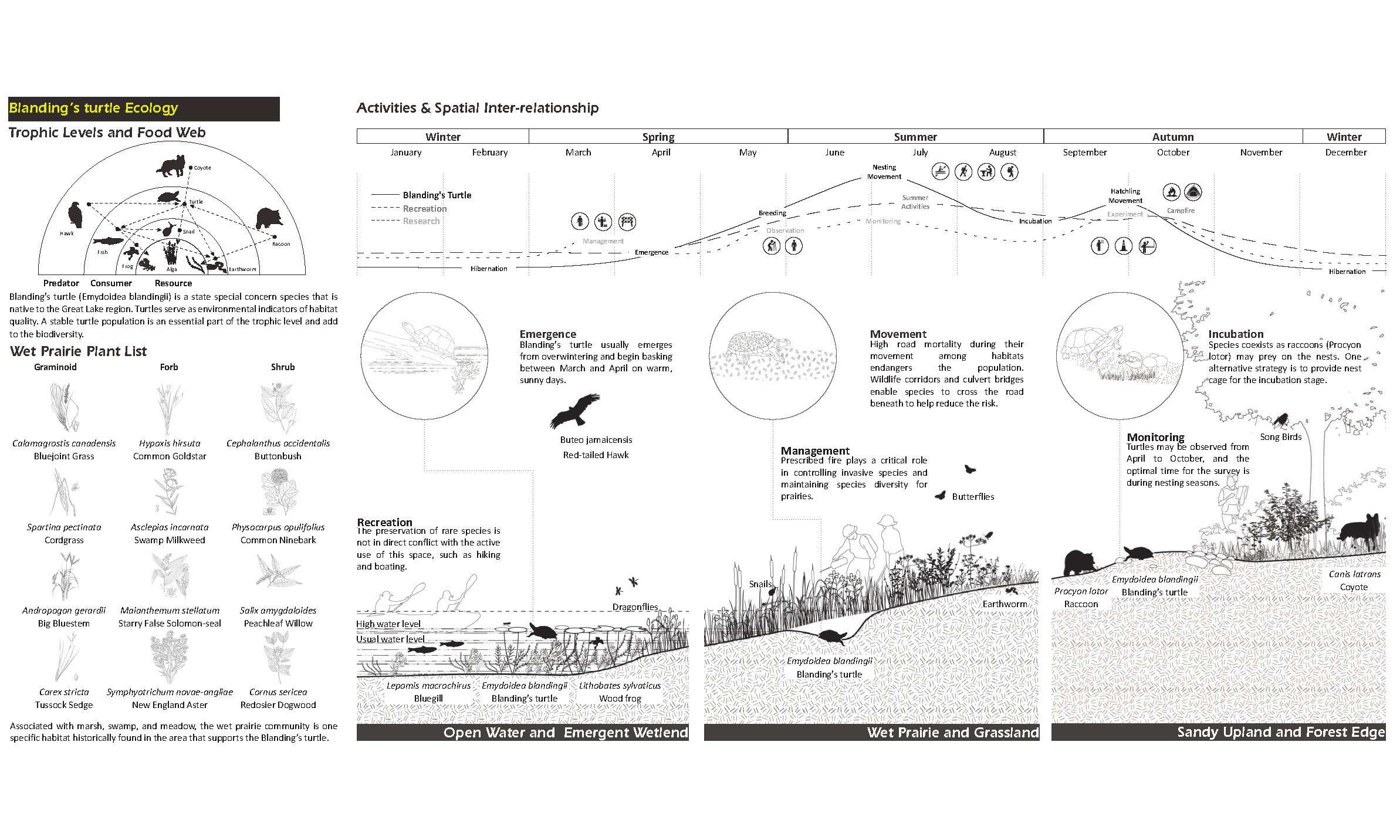
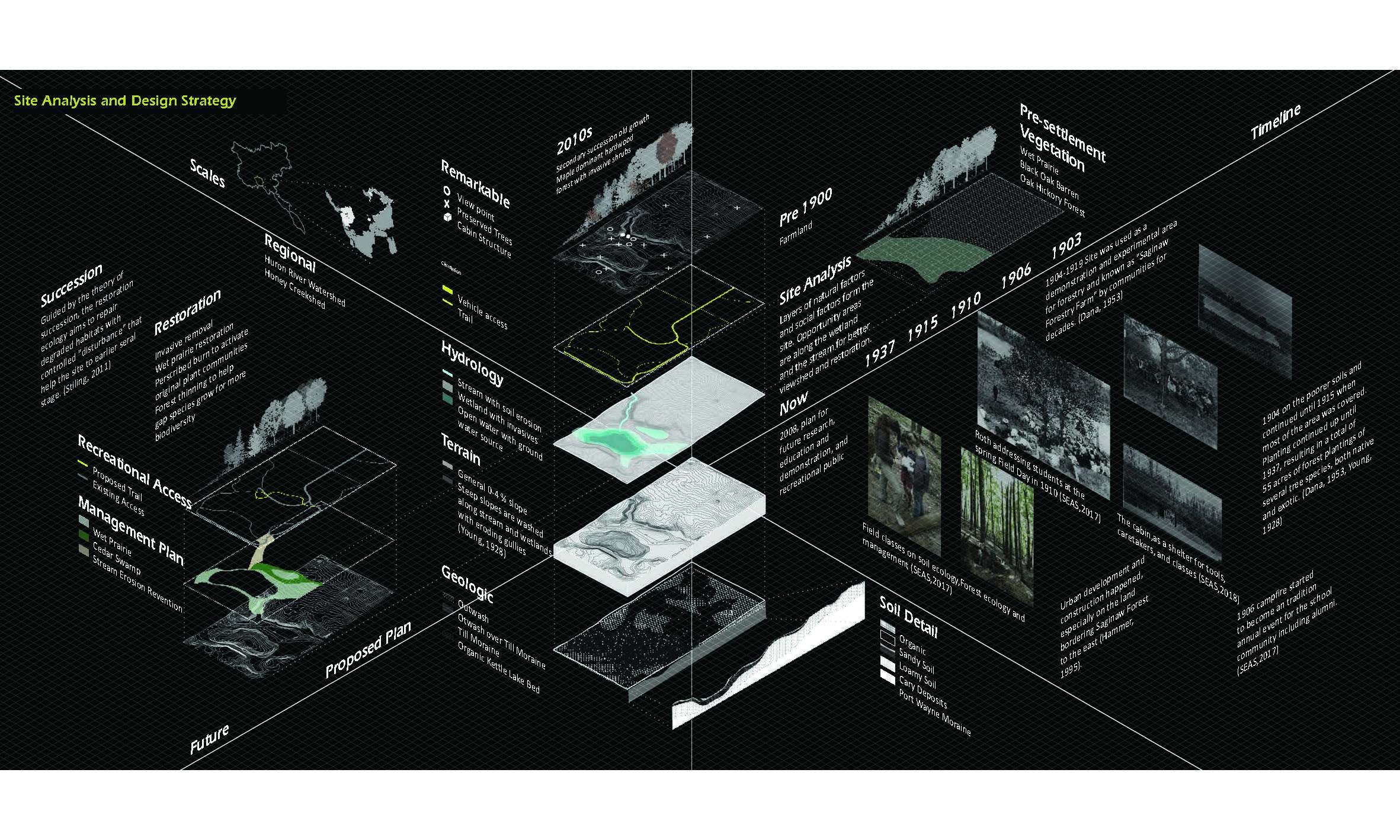
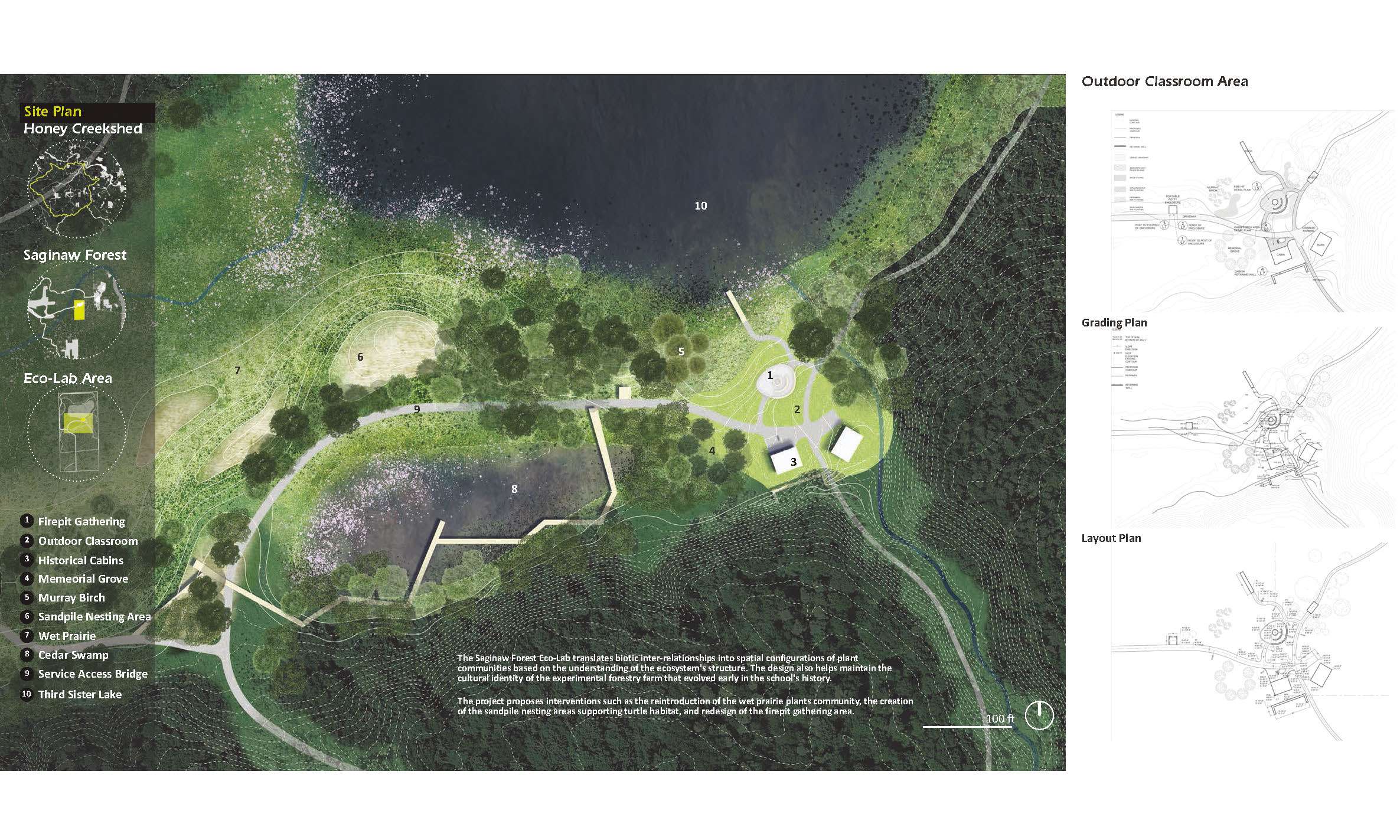
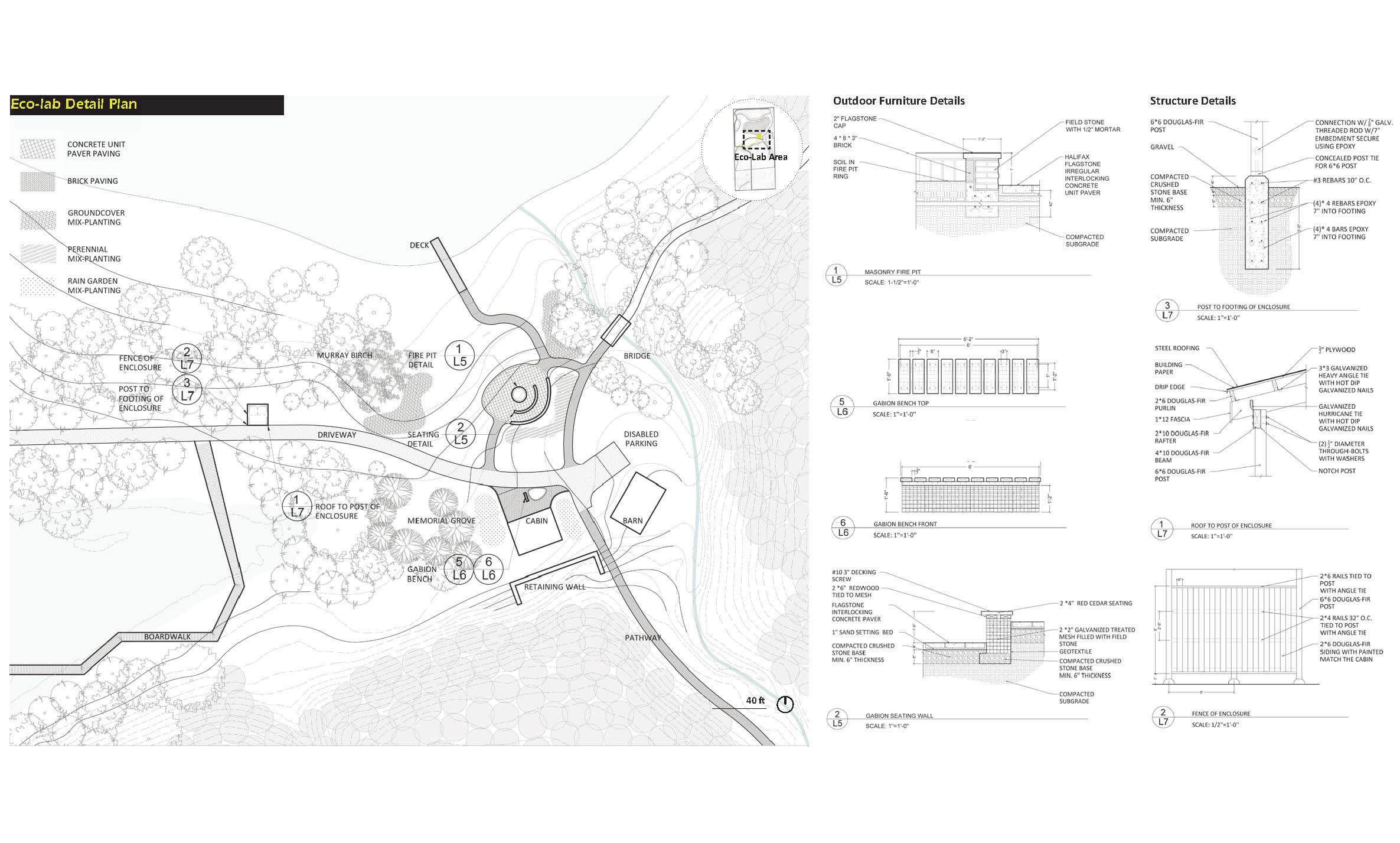
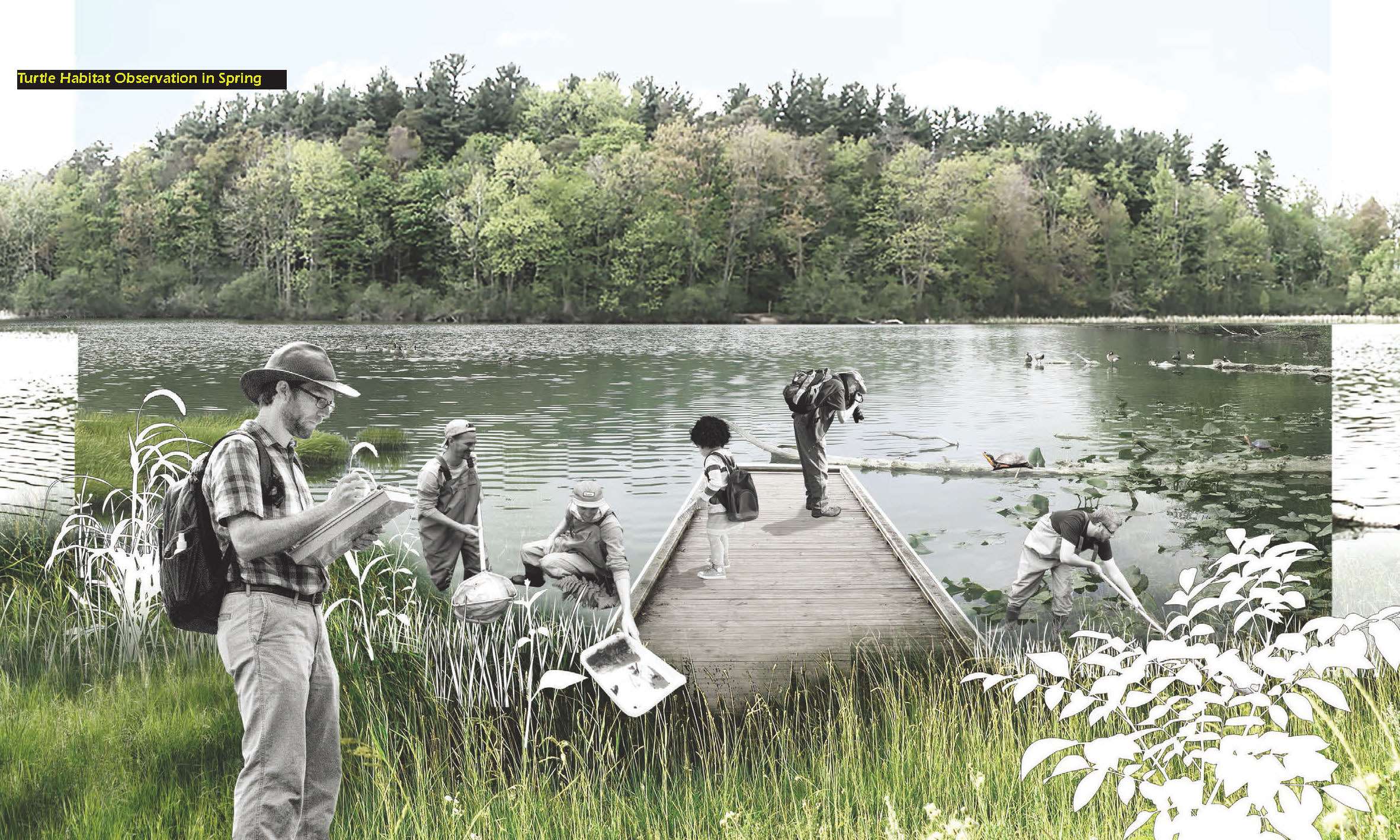
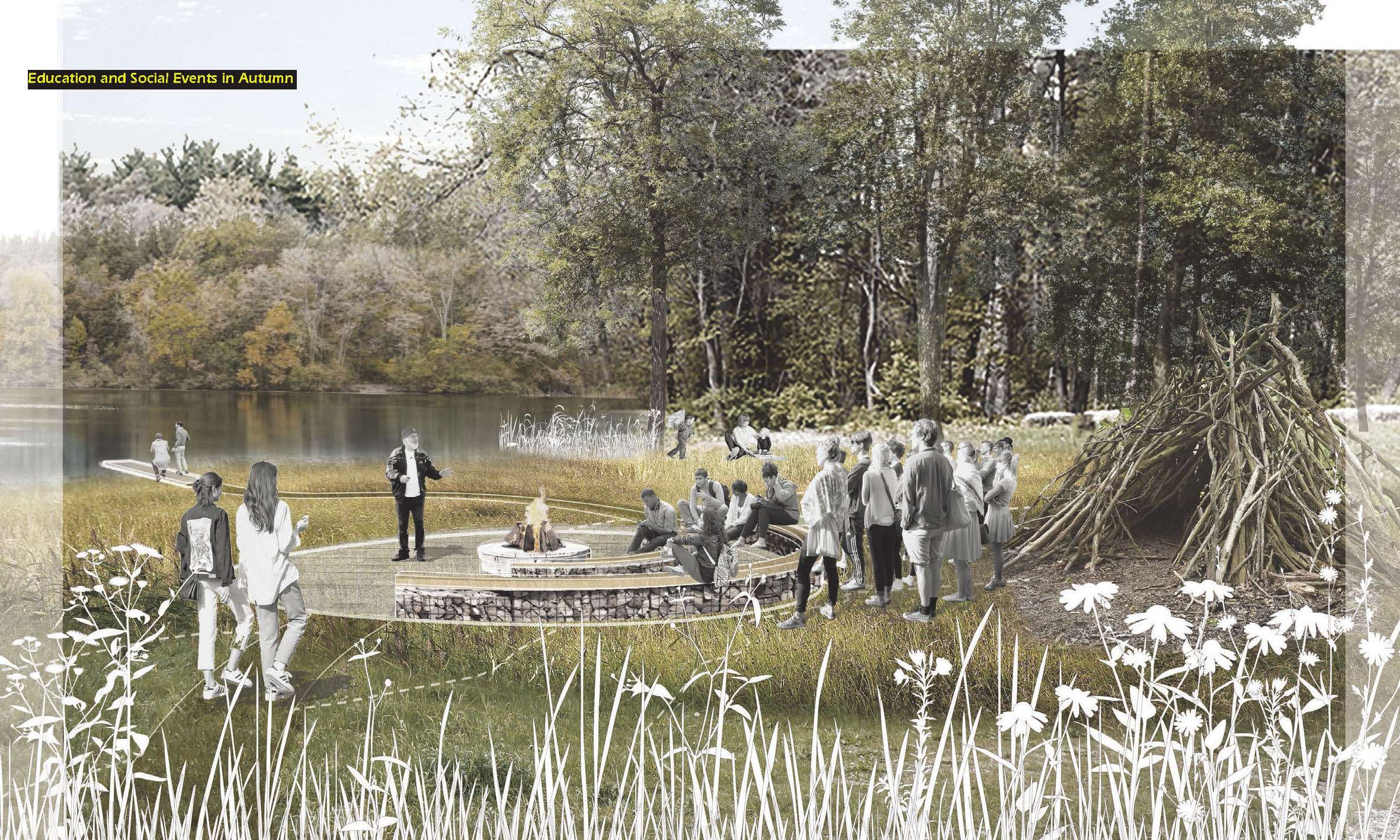
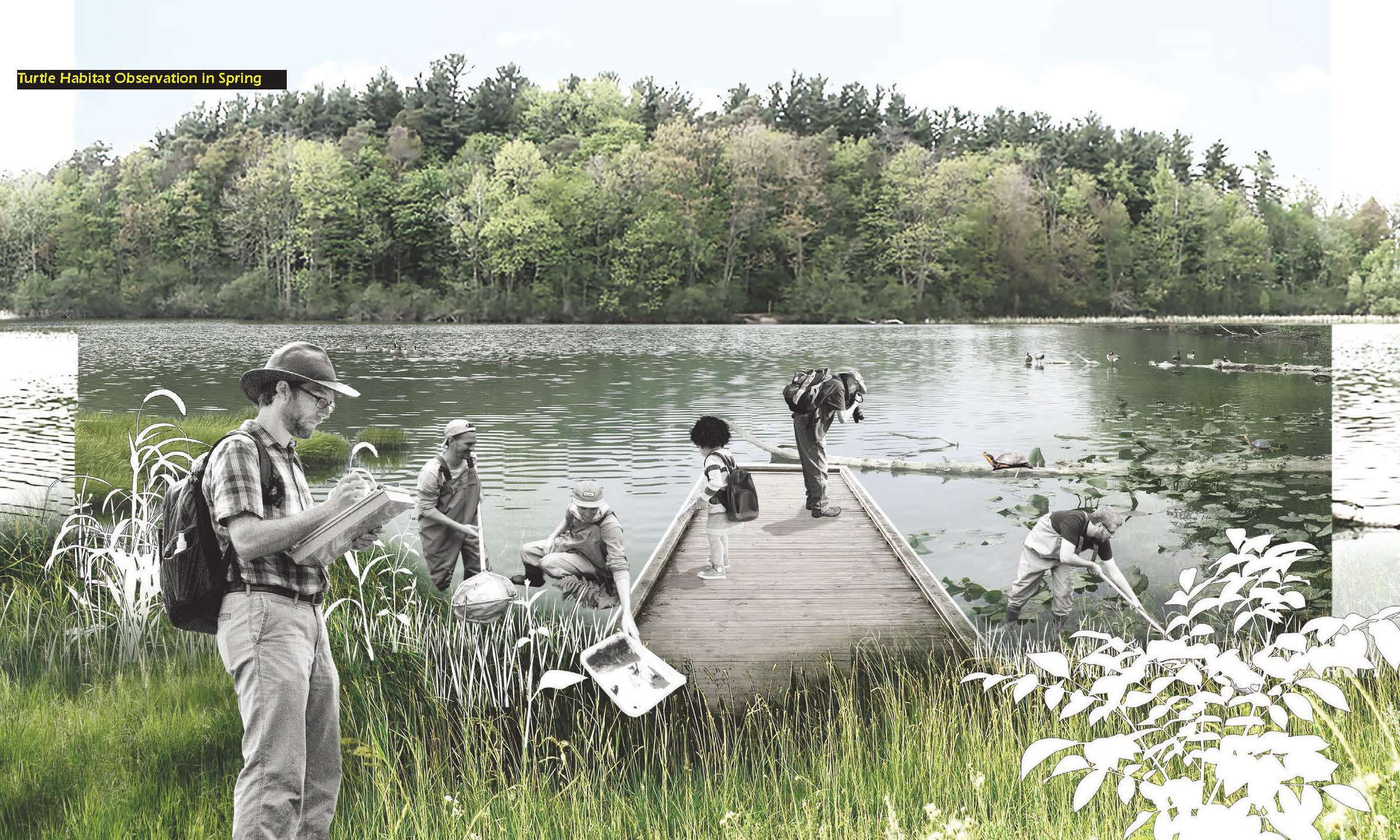
Pebbles Along the Creek: Restoration and Design for Saginaw Forest Eco-Lab
Pebbles Along the Creek: Restoration and Design for Saginaw Forest Eco-Lab
Project Statement
The restoration and design for Saginaw Forest Eco-Lab emphasize the importance of understanding of a place through research-based ecological design both at site and landscape scale. This project has the goal of conserving pivotal wildlife species and their habitats in response to biodiversity loss caused by urban sprawl.
This design proposes transforming Saginaw Forest, an institutional property, into an Eco-Lab for education, research, and outreach. Saginaw Forest has an abounding history as the former “forestry farm,” features a kettle lake (Third Sister Lake), and is actively used both by broader community as well as by the university. With adaptive management strategies and detail designs as complements, the site-scale design intends to connect people with nature by offering gathering, observing areas, and recreation amenities.
Like pebbles along the creek, this project is modest but strong when it recalls the memory of closeness with water and nature. The design aims to create ecological and cultural sustainability to evoke the love and stewardship of nature for a sustainable future.
Project Narrative
CHALLENGE AND OPPORTUNITY
Biodiversity Loss in the Urban Watershed and Metropolis
Incessant urban sprawl in Southeast Michigan metropolis degrades wetlands and has often replaced them with farmlands and then urban settlements over time. This causes fragmented wildlife habitats and leads to the loss of biodiversity that threatens the environmental sustainability of Huron River watershed. Located aside urbanized postindustrial Southeast Michigan metropolis, about 44% of the Huron River watershed is in natural preserves, forests, wetlands, and fields. As home to numerous animals and plants life, including over 90 species of fish and over 30 species of reptiles and amphibians, habitat restoration planning is imperative to help the area continue to support a diversity of life.
Situated in the Honey creekshed, which historically featured a mosaic of wetlands, prairie, oak barrens, and woodland, Saginaw Forest is an institutional property optimal to be an Eco-Lab. With the school’s mission for teaching, research, and public outreach, restoring the integrity of habitats in Saginaw Forest enhances the use of the property as a lab environment for education and research while also supporting recreational use of the site’s trails and open spaces. The Saginaw Forest Eco-Lab project is not only a critical step to regional restoration of the creekshed but also provides an opportunity to redesign the interface between human activities and nature at the site. Through sound ecological design, Eco-Lab creates better access to recreation and community outreach activities while restoring unique natural habitats found around Third Sister Lake.
RESTORATION RESEARCH AND SITE ANALYSIS
Key Amphibian’s Habitat Restoration
The restoration plan aims to promote ecosystem services such as being a wildlife refuge that supports native plants and animals and regulating the hydrological condition to prevent flooding. Targeted species here is the native Blanding’s turtle (Emydoidea blandingii). Multi-criteria decision analysis comes into use to conduct the amphibian habitat suitability analysis based on the environmental factors and constraints. This analysis verifies that the Saginaw Forest site is optimal for the restoration along with other sites as alternatives. The scientific conclusions were used to drive further site-scale design decisions.
Turtles serve as environmental indicators of habitat quality. A stable turtle population is an essential part of the trophic level and add to the biodiversity. Research on the turtle ecology identifies the spatial taxonomy that supports this species. Wetlands and upland nesting areas are critical conservation needs. Associated with marsh, swamp, and meadow, the wet prairie community is one specific habitat historically found in the area that supports the Blanding’s turtle. By mapping out spatial inter-relationship among species and the critical habitats used by turtles throughout the year, the research calls for coordinating human activities with critical periods in a turtle's life.
A Rich Geological History of the Kettle Lake and the Precious Cultural Heritage
Environmentally, Saginaw Forest has a rich geological history of the kettle lake on-site with layers of soil left by the glacial retreat. Date back to pre-settlement, the site was a composition of wet prairie, black oak barren, and oak-hickory forest. It was transformed into farmland and then converted to a forestry farm. More recently, urban developments have surrounded the property. The property is now a mix of old forestry plots and secondary hardwood forest with many invasions by non-native exotic shrubs and herbaceous plants. Socially, this beloved area has been a demonstration and experimental area for decades since 1903. Campfire events, field trips by science classes, and environmental research take place regularly.
DESIGN APPROACH AND STRATEGY
Designs as Pebbles Along the Creek
The Saginaw Forest Eco-Lab project translates biotic inter-relationships into spatial configurations of plant communities based on the understanding of the structure of the ecosystem. The design also helps maintain the cultural identity of the experimental forestry farm that evolved early in the school’s history. The project proposes interventions such as the reintroduction of the wet prairie plants community, the creation of the sandpile nesting areas supporting turtle habitat, and redesign of the firepit gathering area.
To create suitable aquatic and terrestrial habitats for Blanding’s turtle, the design reintroduces the wet prairie community into the site. That builds on sandy mounds earthworks to add to the variation of the landforms. Surrounding these earthworks with shrub planting ensures a safer environment to prevent road mortality for the targeted turtle species.
The firepit gathering area, a metaphor of the pebble along this kettle lake at the end moraine, is the stage for the social events, outdoor teaching, and experiments. Layering texture created by surrounding sloping seating reflects the geological history.
A pedestrian boardwalk connects people with the restored habitat for observing and monitoring the wildlife at a distance. Overhang decks at several turning points invite visitors to the stunning view when walking along this zigzag route.
Habitat restoration and design are inseparable from adaptive management strategies. In addition to regular Blanding’s Turtle population assessment, the success of wetland plant communities will rely largely on the targeted reduction of invasive woody and herbaceous plant species. Prescribed fire plays a critical role in maintaining species diversity for prairies. Hot burning should be planned in the springs to control the invasive species and stimulate the growth of native prairie seeds as block removal approach. Invasive species control should be measured by field surveys and monitoring.
The events area can stay open year-round, while vehicle access to the restoration area should be managed during nesting time to eliminate the road mortality. The pedestrian boardwalk serves as an alternative route when the main pathway is closed for preservation.
Materiality and Construction Detail Design
The detail design strategy accommodates sustainable materials and construction methods to minimize the ecological cost and impact of construction and implementation. Grading improves the hydrology of run-off onsite towards the meadow area to help preserve the rare species, Murray Birch. As for materiality, the detail design recommends using durable material such as unit paver and gravel gabions for low maintenance need. This may minimize the use of concrete and the need for heavy construction for the restoration plan.
CONCLUSION
When leaves sprout and early blooms emerge in spring, it is the time for wildlife observation and restoration management. During autumn, events and classes enlighten the area when people are gathering along with the campfire, conducting experiments in the wetland and forest. The project proposes a dynamic landscape that attracts people in all seasons.
Like pebbles along the creek, this project is modest but strong when it recalls the memory of closeness with water and nature. The preservation of rare species is not in direct conflict with the active use of this space. This place is not further destroyed but instead flourishes. The design weaves together ecological and social benefits evoking the love and stewardship of nature for a sustainable future.
